Think back to the last time you chose a brand. It probably wasn’t just about the product; it was about how the interaction made you feel. That seamless, personalized experience is what today’s customers expect, and it has become the real differentiator in a world of endless choices and short attention spans.
The stakes are high: 32% of customers will stop buying from a brand they love after just one bad experience. Meeting modern customer expectations requires more than speed; it demands journeys that are intuitive, consistent, and emotionally resonant across every customer touchpoint. Brands embracing customer experience transformation don’t just react; they anticipate, creating experiences that foster customer loyalty and meaningful engagement.
The business impact is clear. When personalization is executed well, companies can see a 5–15% increase in revenues and a 10–30% improvement in marketing ROI. Consumers are willing to pay more for superior experiences: 16% more for better experiences, 42% for friendly service, and 52% for speed. Experience-driven transformation drives measurable outcomes, enhancing customer satisfaction, retention, and customer lifetime value, while directly contributing to business success.
True customer experience transformation isn’t just about tools or optimizing touchpoints. It’s about aligning strategy, culture, technology, and customer data to deliver connected, intelligent, and scalable experiences that evolve with customers’ needs.
In this blog, we’ll explore what customer experience transformation means in 2025, why it’s essential, how customer expectations are shifting, which metrics matter, how leading brands innovate, and actionable steps to stay ahead so you’ll understand not just the “why,” but also the “how” of delivering a seamless, valued, and memorable experience that drives real growth.
What exactly is customer experience transformation
Customer experience transformation is a strategic, organization-wide reinvention of how a business understands, delivers, and evolves value across every customer interaction. It is rooted in a life-centric perspective, reflecting the reality that 95% of executives say customers are changing faster than businesses can keep up.
Unlike traditional customer experience, which measures perception of individual touchpoints, customer experience transformation encompasses the entire experience ecosystem, aligning strategy, culture, operations, and technology to make interactions smarter, more human, and deeply responsive to evolving customer expectations.
At its core, it is a deliberate shift from transactional improvements to a continuous, adaptive approach that creates meaningful, customer-centered experiences.
From incremental improvements to strategic reinvention
In the past, improving customer experience meant optimizing individual customer touchpoints, speeding response times, refining digital interfaces, or training frontline teams. However, by 2025, these isolated improvements will no longer be sufficient. Today’s customers navigate unpredictable circumstances, balancing what they want, need, and expect in real time.
Static, linear customer journeys no longer reflect reality. Transformation requires reimagining the entire experience ecosystem, including culture, operations, customer data, and technology, to deliver engagement that evolves alongside customers’ lives. It’s the shift from asking, “How do we serve better?” to “How do we evolve alongside our customers?”
The four core pillars of customer experience transformation
To achieve life-centric, unified engagement, companies must transform across four foundational areas.
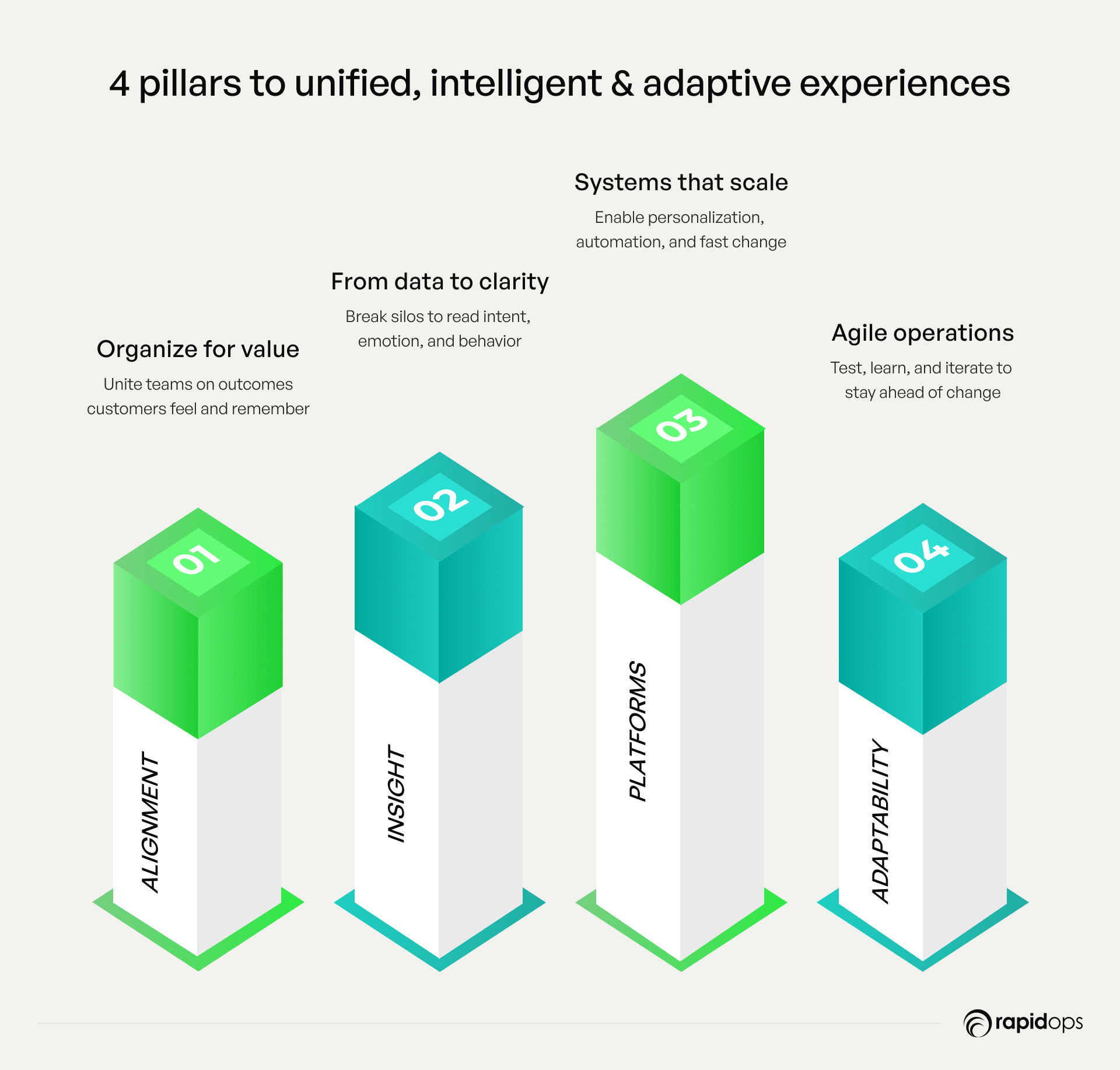
1. Customer-centric culture shift
Transformation starts with mindset. Organizations must align leadership and frontline teams around delivering meaningful outcomes, not just transactions. Fostering a customer-centric culture ensures every decision centers on customer needs, creating experiences that inspire loyalty and engagement.
2. Connected data and intelligence
Experience thrives on insight. Breaking down silos and unifying customer data across systems enables companies to understand customer behavior, intent, and emotions in real-time. Leveraging predictive analytics and actionable insights allows brands to anticipate needs and deliver personalized, seamless experiences.
3. Experience-driven technology
Technology should enable, not complicate. Platforms that integrate agility, personalization, and automation make interactions smoother, reduce service costs, and enhance customer satisfaction across digital channels and touchpoints.
4. Adaptive operating models
Transformation is continuous. Agile, test-and-learn operations incorporate customer feedback, iterate rapidly, and evolve in response to shifting customer expectations. Nearly 80% of American consumers cite speed, convenience, knowledgeable help, and friendly service as the most critical elements of a positive experience, emphasizing the importance of adaptive, life-centric operations.
By integrating culture, data, technology, and adaptive operations, customer experience transformation enables businesses to deliver seamless, personalized experiences that anticipate needs, foster loyalty, and drive lasting value.
What’s driving the need for customer experience transformation in 2025
Customer experience transformation in 2025 is driven by evolving expectations, not just disruption. Today’s customers measure brands against the best experience they’ve ever had, anywhere, demanding precision, empathy, and relevance at every interaction. This shift is rewriting loyalty and forcing organizations to rethink how they design, deliver, and continuously evolve customer experiences across all touchpoints.
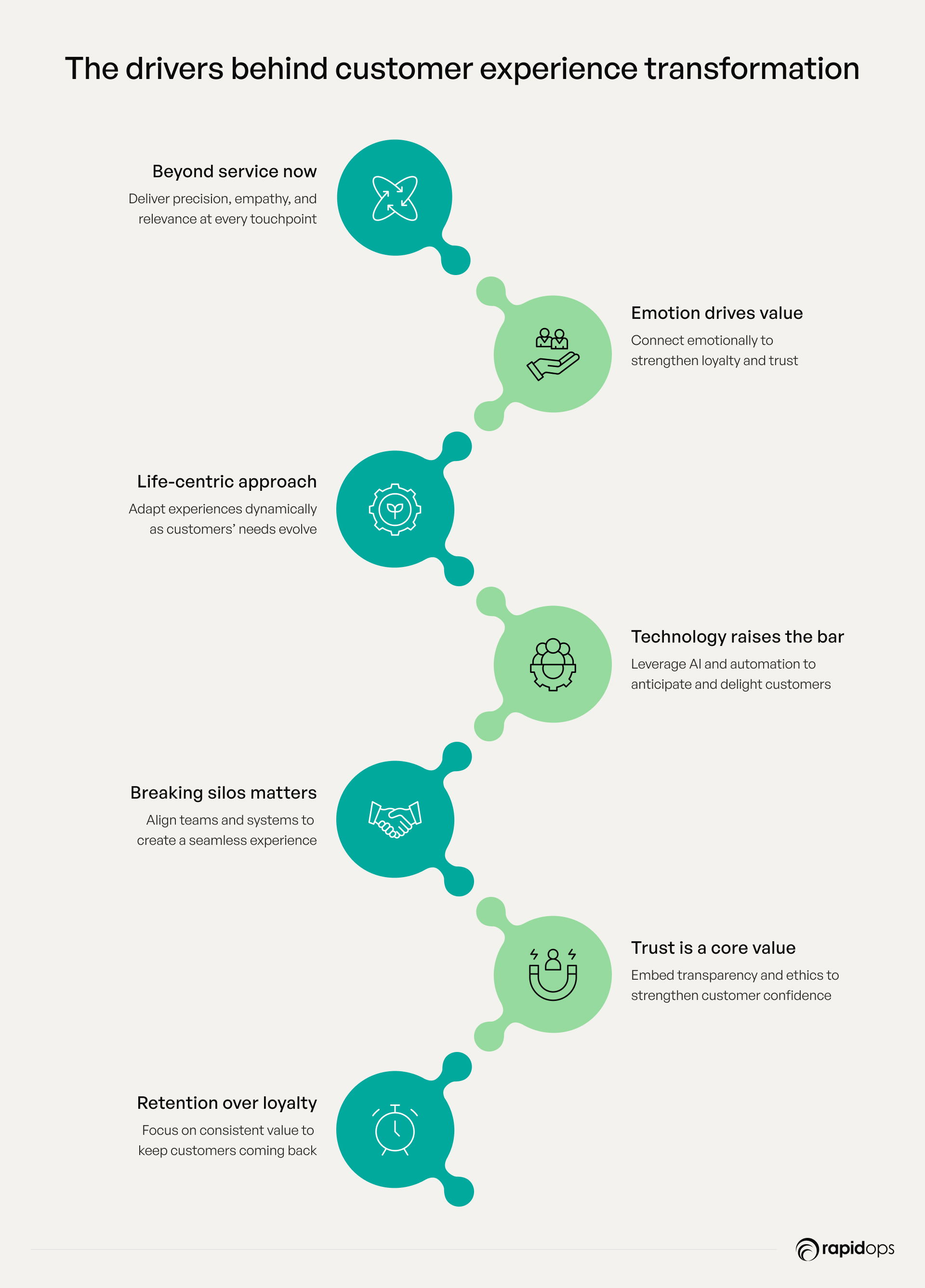
1. Customers demand precision, empathy, and contextual relevance
Modern buyers expect integrated, seamless experiences across channels, departments, and touchpoints. Real-time personalization and predictive engagement are no longer optional 71% of customers expect personalized interactions, while 76% report frustration when personalization is missing. Surface-level improvements no longer foster loyalty; organizations must unify data and decisioning to deliver consistent, adaptive, life-centric experiences at scale.
2. Emotional resonance is the new competitive differentiator
In saturated markets, emotional connection drives lasting loyalty. Brands that lead in emotional engagement outperform competitors by over 80% in retention and advocacy (Forrester). Experiences must reflect empathy, understanding, and human context, embedding emotional intelligence across design, communication, and product interaction.
3. The rise of the life-centric customer
Traditional segmentation is outdated. Customers are multifaceted, navigating shifting life stages, economic conditions, and societal change. 95% of executives report that customers are changing faster than businesses can keep up. Organizations must adopt a life-centric approach, transitioning from linear journey maps to dynamic experience systems that evolve in tandem with customers’ lives.
4. Technology sets new expectations
AI, automation, and predictive analytics have reset the bar. By 2025, most service organizations are expected to implement generative AI; by 2029, agentic AI is projected to resolve 80% of common issues while reducing costs by 30%. Customers now benchmark brands like Amazon, Apple, and Spotify for intuitive, proactive, and personalized interactions. Transformation requires orchestrating people, processes, and technology to anticipate intent and enhance emotional engagement, rather than just automating transactions.
5. Fragmented organizations disrupt experiences
Disconnected teams, channels, and data create friction. Transformation dissolves silos, aligns cross-functional efforts, and unifies customer insights around a single truth: the journey. Companies with strong cross-functional CX alignment grow three times faster than peers (McKinsey), demonstrating that enterprise-wide accountability is critical.
6. Trust and values are central to customer decisions
Belief-driven buying is on the rise, with nearly two-thirds of consumers purchasing or boycotting based on a brand’s stance on social, environmental, or ethical issues. Trust has become a purchase factor 81% say “do what is right” is a top reason to buy. Integrating trust-by-design into governance, data usage, and experience design ensures transparency, promotes ethical AI, and fosters value alignment, thereby building loyalty and mitigating reputational risk.
7. Loyalty is fragile; retention is the true growth lever
Switching brands is effortless, and the loyalty of yesterday no longer exists. 61% of customers will abandon a brand after one poor experience (PwC). Retention now depends on delivering continuous, personalized, and emotionally resonant experiences. Customer experience transformation enables proactive and predictive engagement, securing customer lifetime value.
8. The cost of inaction is accelerating
Delay carries measurable risk: lost loyalty, churn, negative word-of-mouth, and declining relevance. Organizations that treat transformation as a continuous, adaptive system outperform laggards by nearly 80% in revenue growth (Forrester). Transformation is no longer a one-off project; it is an enterprise-wide, strategic imperative.
In 2025, the drivers of customer experience transformation, including personalization, AI adoption, life-centric design, emotional resonance, and trust, represent a fundamental shift in how value is experienced and delivered.
Leaders must evolve systems, culture, data, and technology to meet expectations, anticipate needs, and create experiences that are seamless, meaningful, and enduring.
Understanding customer expectations in 2025
In 2025, customer expectations are dynamic, highly personalized, and context-driven. Customers compare your brand to the best experiences they’ve ever had, not just competitors. Understanding these expectations is essential to anticipate needs, orchestrate seamless interactions, and align culture, technology, and processes for meaningful engagement and loyalty.
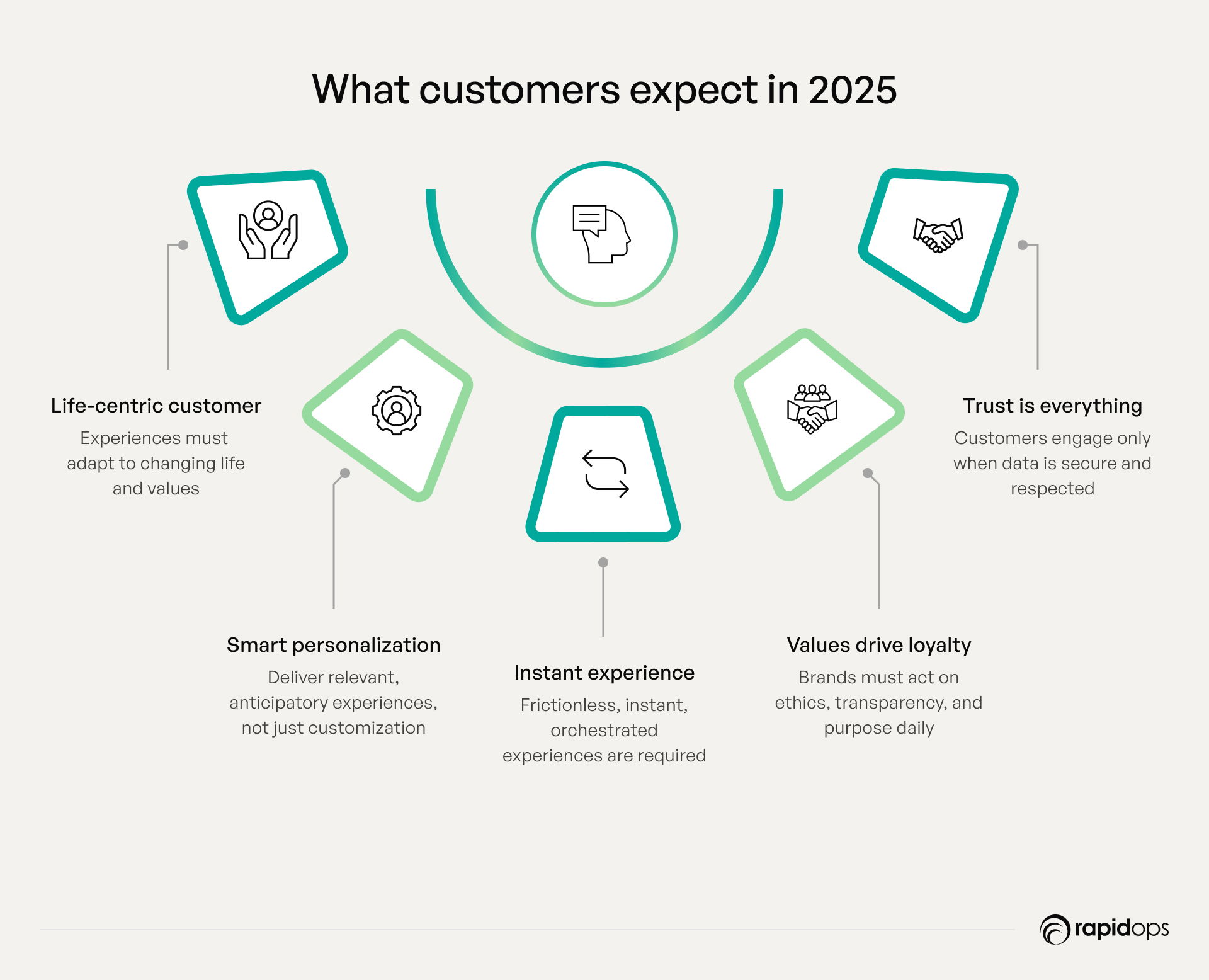
1. The rise of the life-centric customer
Traditional personas no longer suffice. Customers are complex, evolving humans whose decisions are influenced by personal needs, emotional context, values, and life circumstances. This life-centric perspective requires businesses to move beyond linear customer journeys and segmented approaches, instead designing adaptive experience systems that evolve in real time.
Recognizing these nuances enables organizations to anticipate customer needs, deliver relevant interactions, and create meaningful engagement that drives customer satisfaction and loyalty.
2. Intelligent personalization as a baseline
Personalization in 2025 is expected to be anticipatory, not superficial. Seventy-one percent of customers expect personalized interactions, yet 76% feel frustrated when personalization is missing. Leveraging unified customer data platforms, predictive analytics, and AI-driven insights enables brands to understand behavior, intent, and preferences in real-time. Personalization becomes a mechanism for delivering seamless experiences that are contextually relevant, emotionally resonant, and aligned with evolving customer expectations.
3. Orchestrated omnichannel experiences
Customers no longer distinguish between digital channels, physical touchpoints, or service interactions; they expect an integrated, frictionless journey across all channels. Seventy-three percent of customers believe companies should inherently understand their expectations, and 62% expect companies to proactively anticipate their needs.
Organizations that deliver orchestrated omnichannel experiences see measurable benefits: CSAT scores of 67% versus 28% for disconnected, multi-channel approaches. Integrated systems, actionable insights, and aligned internal processes are crucial for transforming these expectations into tangible business outcomes.
4. Trust as the foundation of engagement
Trust has become the new currency of experience. Consumers scrutinize how brands use data, their alignment with social and ethical values, and the transparency of AI and automation. Three-quarters of customers will not engage with companies they do not trust, and 68% believe trustworthy AI is critical for personalized experiences. By embedding trust-by-design in every touchpoint from data governance to AI-powered decisioning, organizations can foster loyalty, reduce churn, and strengthen customer lifetime value.
5. Clear value exchange encourages engagement
Customers are willing to share their data only when the value is evident. Sixty-three percent of consumers indicate they would provide more personal information to brands that deliver a great experience. This underscores the importance of transparent communication, actionable insights, and intelligent orchestration of services.
When brands demonstrate measurable benefits for customers through speed, convenience, personalization, and empathy, they reinforce both engagement and loyalty while optimizing overall customer satisfaction.
6. Speed, simplicity, and seamlessness are non-negotiable
Time-starved, digitally fluent customers expect immediacy without compromise. Delays, friction, or inconsistencies at any touchpoint risk disengagement. In 2025, the ability to deliver seamless experiences across customer interactions, from mobile apps to service delivery and AI-driven self-service, is a defining factor in satisfaction, loyalty, and retention. Integrating predictive analytics, continuous improvement frameworks, and customer feedback mechanisms enables organizations to stay responsive to evolving needs.
To meet these evolving expectations, you must leverage real-time insights, intelligent personalization, and transparency in every interaction. Brands that act on these signals, delivering experiences that feel intuitive and empathetic, turn customer expectations into loyalty and sustainable business value.
How to implement customer experience transformation
Transformation succeeds when it is purposeful, strategic, and actionable. This section addresses how businesses can move from aspiration to execution, embedding customer value at the core of every interaction and decision.
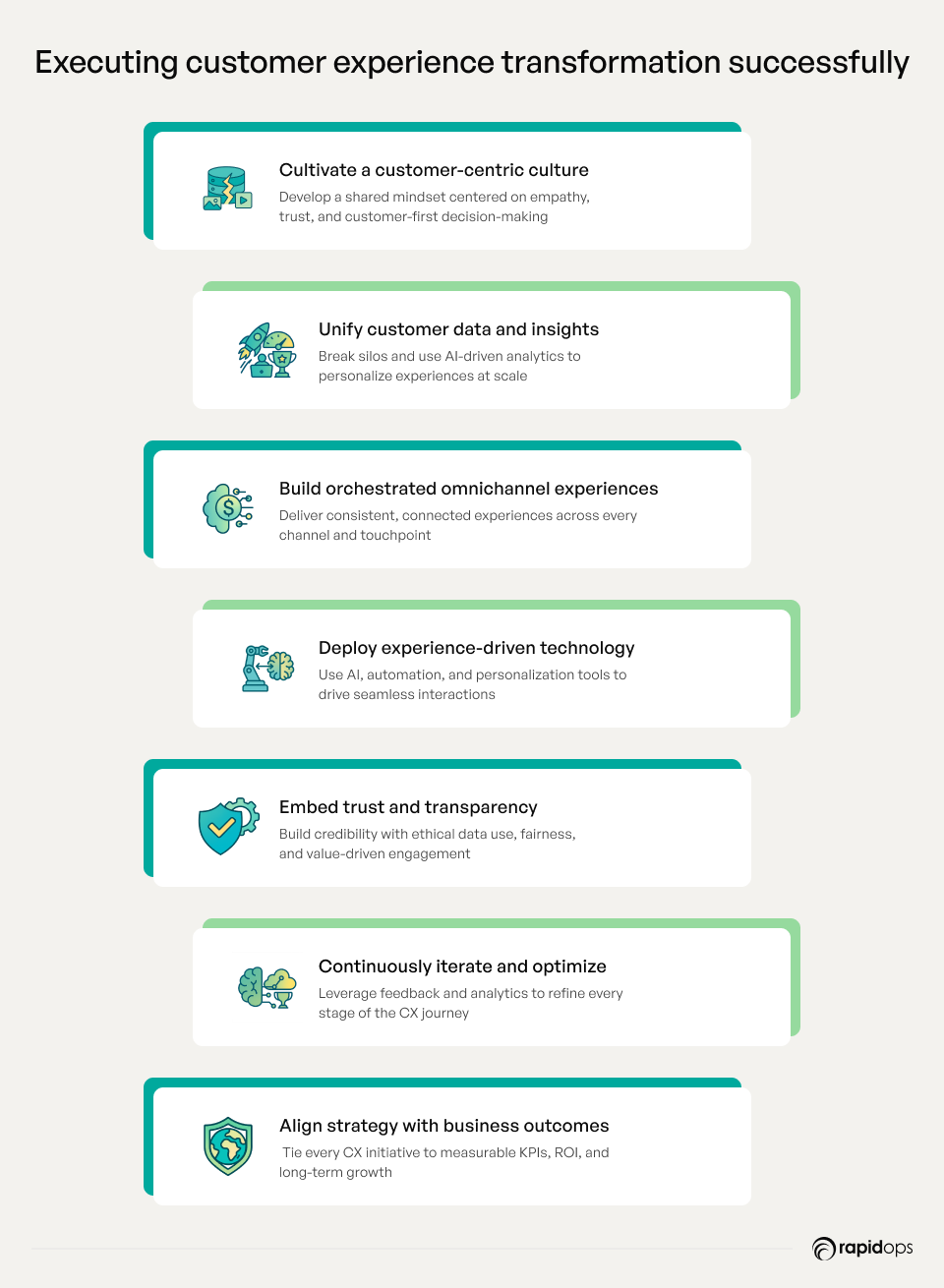
1. Cultivate a customer-centric culture
Transformation begins with mindset. Align leadership and frontline teams around shared goals of delivering meaningful outcomes rather than just transactional efficiency. Develop a customer-centric culture where every decision reflects customer needs, expectations, and emotional context. Equip teams with training in empathy, communication, and problem-solving to ensure that every touchpoint—from sales to service—reinforces trust and satisfaction. Embedding a customer-centric culture enables organizations to proactively resolve customer issues and foster loyalty across every interaction.
2. Unify customer data and actionable insights
Customer experience transformation relies on a single source of truth. Break down silos to consolidate customer data from multiple channels and platforms into unified systems, including customer data platforms. Leverage predictive analytics, machine learning, and AI-driven insights to anticipate customer behavior, identify pain points, and personalize interactions in real time. By transforming raw data into actionable insights, organizations can gain a deeper understanding of customer needs, optimize customer touchpoints, and deliver seamless experiences that drive overall satisfaction and engagement.
3. Build orchestrated omnichannel experiences
Modern customers expect seamless, integrated, and consistent interactions across digital channels, physical touchpoints, and service interactions. Seventy-three percent of consumers believe companies should inherently understand their expectations, while 62% expect companies to proactively anticipate their needs.
Implementing orchestrated omnichannel systems ensures that customers experience continuity and reliability, improving customer satisfaction and loyalty. Coordinated internal processes, aligned teams, and integrated technology are crucial for delivering seamless service and fostering positive customer interactions.
4. Deploy experience-driven technology
Technology must enable transformation, not complicate it. Integrate platforms that support automation, predictive personalization, and real-time responsiveness. By implementing experience-driven technology, such as generative AI and intelligent automation, companies can anticipate customer needs more effectively, resolve issues efficiently, and reduce service costs. AI-powered decisioning ensures personalized engagement at scale, delivering value while preserving trust, especially when paired with trust-by-design practices.
5. Embed trust and transparency
In an era where belief-driven buying dominates, trust has become the currency of engagement. Nearly two-thirds of consumers choose, or boycott brands based on values, and 81% say “do what is right” is a top purchase factor. Embed transparency into data governance, AI usage, and personalization strategies to build credibility. Organizations that prioritize trust see higher customer loyalty, retention, and lifetime value, while also creating a culture of accountability and ethical behavior.
6. Continuously iterate and optimize
CX transformation is a dynamic process. Use customer feedback, real-time analytics, and performance metrics to inform ongoing improvements. Implement a continuous improvement framework that refines internal processes, service delivery, and customer touchpoints to enhance overall customer experience. Monitor customer satisfaction scores, engagement metrics, and loyalty indicators to ensure the transformation delivers measurable business benefits. By evolving in line with shifting customer expectations, organizations can maintain a competitive advantage and foster brand loyalty.
7. Align strategy with business outcomes
Every step of the transformation should be connected to measurable results. Establish clear KPIs across customer experience, customer satisfaction, customer engagement, and customer lifetime value. Use these metrics to guide decisions, justify investments in customer data platforms, technology, and employee capabilities, and communicate success across the organization. Aligning strategy, culture, and operations ensures that transformation is not an isolated initiative but an enterprise-wide capability that drives business success and sustainable growth.
Implementing a customer experience transformation requires more than tools; it demands a unified vision, integrated systems, and a customer-centric mindset that is embedded across the organization.
Companies that execute customer experience transformation effectively don’t just meet expectations, they anticipate needs, foster trust, and create seamless, emotionally resonant experiences that drive long-term loyalty and measurable business value.
Key success metrics for customer experience transformation
Driving meaningful customer experience transformation requires more than intent; it demands measurable proof of progress. Organizations must link initiatives to KPIs that reflect customer satisfaction, engagement, loyalty, and long-term value, turning insights into actionable strategies. Monitoring these metrics ensures CX efforts deliver tangible business benefits, optimize customer touchpoints, and reinforce a customer-centric culture.
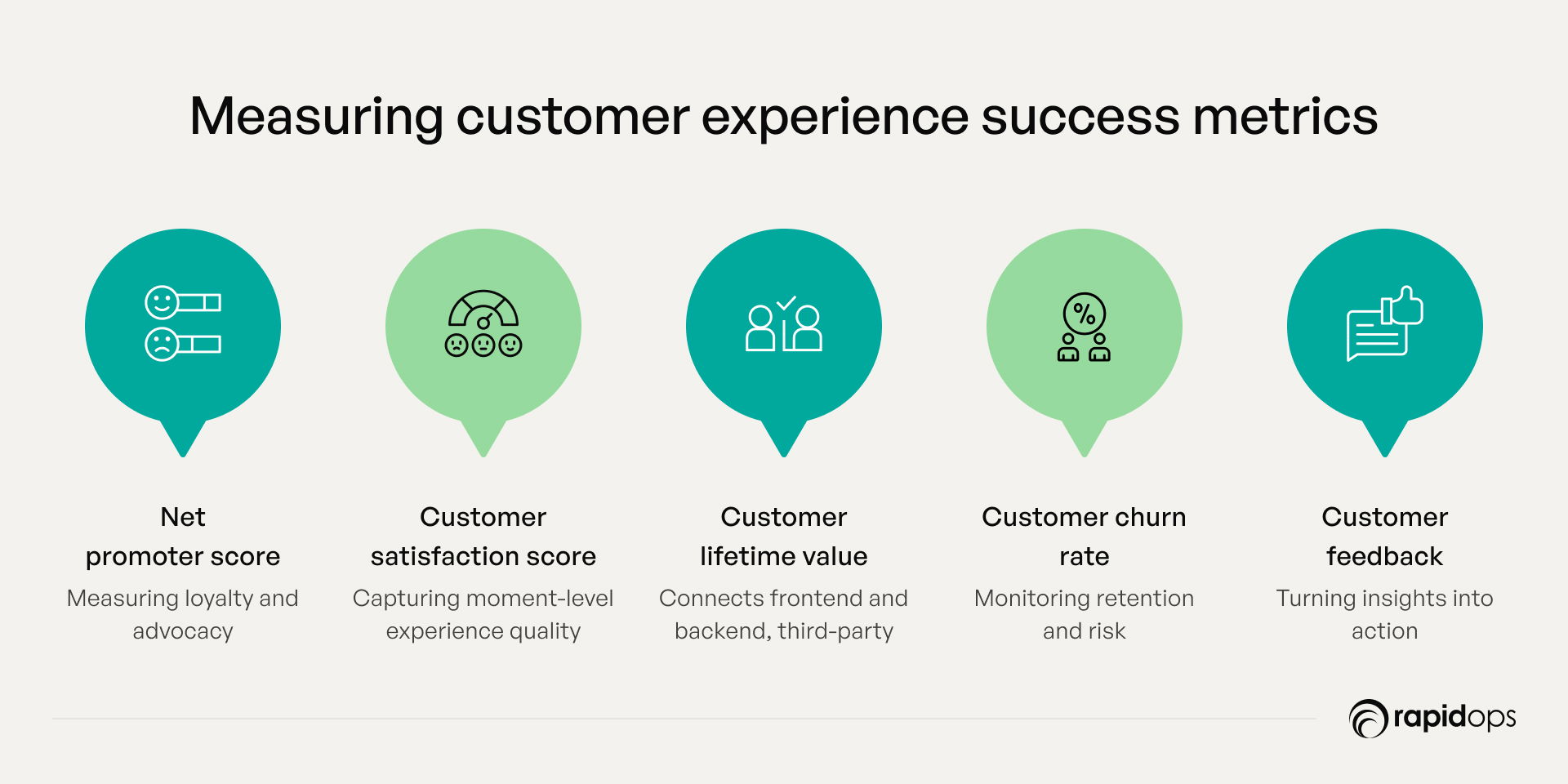
1. Net promoter score (NPS): Measuring loyalty and advocacy
What it tells you: NPS captures customer likelihood to recommend your brand, signaling loyalty, emotional connection, and trust.
Why it matters: A high NPS correlates with accelerated growth and a strong customer-centric mindset, acting as a proxy for overall customer experience quality.
Example: Apple’s consistent NPS of 72 demonstrates how prioritizing customer satisfaction and engagement fosters advocacy and repeat business.
Track NPS across segments and post-interaction cycles to assess the impact of CX transformation and identify opportunities for improvement.
2. Customer satisfaction score (CSAT): Capturing moment-level experience quality
What it tells you: CSAT evaluates satisfaction with specific interactions, products, or services, offering insight into customer perception at critical touchpoints.
Why it matters: High CSAT aligns with increased conversion, retention, and customer loyalty, connecting frontline experience with enterprise outcomes.
Example: Zappos leverages CSAT feedback to continuously refine service delivery, ensuring that every touchpoint reinforces trust and satisfaction.
Implement CSAT surveys after support resolutions, deliveries, or onboarding to detect friction and optimize the journey in real time.
3. Customer effort score (CES): Identifying friction in the experience
What it tells you: CES measures ease of completing a task or resolving an issue, highlighting points of friction in the customer journey.
Why it matters: Lower effort directly improves retention and loyalty; seamless interactions reduce frustration and increase overall satisfaction.
Example: British Gas simplified billing and service processes, enhancing CES and reducing churn by making customer interactions effortless.
Collect CES feedback after self-service, checkout, or support interactions to uncover pain points and prioritize improvements.
4. Customer lifetime value (CLV): Evaluating long-term revenue impact
What it tells you: CLV estimates the revenue a customer contributes over the duration of their relationship, connecting experience quality to financial outcomes.
Why it matters: Higher CLV reflects effective personalization, loyalty programs, and frictionless interactions, reinforcing retention and engagement strategies.
Example: Amazon Prime members generate more than double the CLV of non-members, reflecting how seamless service and tailored experiences drive long-term value.
Monitor CLV by segment and journey stage to assess how transformation initiatives deepen relationships and optimize customer lifetime impact.
5. Customer churn rate: Monitoring retention and risk
What it tells you: Churn tracks the percentage of customers who stop engaging with your brand over time, revealing gaps in experience delivery.
Why it matters: Reducing churn strengthens loyalty and drives measurable business benefits; even a 5% reduction can significantly boost profitability.
Example: Spotify utilizes predictive churn models to anticipate disengagement, enabling proactive and personalized re-engagement through tailored playlists and seamless service.
Combine churn analytics with qualitative feedback to identify root causes and implement targeted retention strategies.
6. Customer feedback: Turning insights into action
What it tells you: Direct surveys and indirect sources (reviews, social listening) uncover what matters most to customers, guiding service optimization.
Why it matters: Acting on feedback enhances satisfaction, trust, and loyalty. Organizations that close the loop on insights see measurable retention gains.
Example: Hyatt Hotels utilizes dynamic feedback tools to continuously evolve services in real-time, addressing sentiment before it escalates into dissatisfaction.
Treat feedback as a living system; integrate into predictive analytics and continuous improvement frameworks to reinforce trust and optimize experiences.
From metrics to momentum
KPIs are only valuable when tied to strategic action. In 2025, leading organizations operationalize insights to eliminate friction, anticipate evolving customer expectations, and scale experiences that resonate. The focus is not on collecting more data, but on leveraging the right metrics customer satisfaction, loyalty, engagement, lifetime value, and friction points — to drive actionable decisions, enhance customer touchpoints, and deliver sustainable business outcomes.
The latest trends shaping customer experience in 2025
AI and machine learning: The future of personalized customer experience
In 2025, AI and machine learning have moved from innovation labs to the heart of customer experience strategy. According to Gartner, 80% of customer service organizations will deploy generative AI to boost agent productivity and transform customer interactions. Yet, the competitive edge lies not in adoption, but in orchestration.
Leading enterprises now leverage AI to:
- Deliver hyper-personalized interactions in real time, using generative models that adapt to customer context, history, and sentiment.
- Empower human agents with AI co-pilots, such as real-time transcription, knowledge assistants, and intelligent routing, to boost speed, accuracy, and morale.
- Enable predictive service through machine learning that detects behavior patterns and resolves issues before they surface.
Comcast’s Ask Me Anything (AMA) exemplifies this shift. By integrating AMA into its service workflow, Comcast enabled live agents to receive context-rich suggestions during calls.
The outcome:
- 10% reduction in average handling time
- Millions saved annually
- Significant uplift in customer satisfaction
Comcast’s success shows how AI, when deployed to enhance, not replace, human intelligence, can rewire customer experience outcomes across efficiency, loyalty, and experience quality.
Smart automation in manufacturing & distribution: Reinventing customer experience from the core
In 2025, manufacturing and distribution leaders are no longer optimizing solely for cost and scale; they’re optimizing for experience. AI, automation, and connected systems have become essential tools to bridge the gap between operational efficiency and customer satisfaction.
PepsiCo exemplifies this shift. Once focused primarily on volume, the company has reengineered its supply chain to deliver faster, more predictable, and CX-aligned outcomes, most recently through AI-powered sortation and sustainability initiatives.
Forward-looking manufacturers now use smart automation to:
- Predict and meet demand with AI-driven forecasting models that reduce stockouts and excess inventory
- Accelerate fulfillment via autonomous warehouse systems that improve speed, accuracy, and responsiveness
- Ensure reliability through predictive maintenance that prevents downtime and secures consistent delivery windows
PepsiCo’s customer experience-driven supply chain includes:
- AI-based demand forecasting that adapts to seasonality and local events
- Autonomous mobile robots (AMRs) and automation systems across distribution centers
- IoT-powered predictive maintenance on bottling and packaging lines
The outcomes:
- Reduced delivery cycle times and fulfillment errors
- Improved on-shelf availability, enhancing customer satisfaction
- Significant operational savings while reinforcing brand reliability
PepsiCo’s transformation reflects a broader industry shift: customer experience is no longer just a customer-facing initiative; it’s a supply chain mandate. By embedding intelligence deep into their operations, manufacturers and distributors are transforming fulfillment into a key differentiator.
Omnichannel integration: Providing a seamless customer journey
In 2025, customer journeys are nonlinear, weaving through apps, stores, chats, and social platforms. Yet customers expect it to feel like one smooth, unified experience. Disjointed touchpoints break trust. To stay competitive, brands must create frictionless, connected ecosystems that feel effortless from start to finish.
Case in point: Hugo Boss’ Omnichannel ecosystem transformation
Hugo Boss, a global fashion house, reimagined its customer experience to unify discovery, decision-making, and delivery, online and offline. The goal: deliver high-end personalization and consistency at every interaction point.
What Hugo Boss did:
- Implemented Adobe’s 3D design and 360° product visualization tools to enhance product discovery across web and in-store environments.
- Built a synchronized commerce ecosystem that connects hugoboss.com, flagship retail stores, and social media campaigns.
- Enabled real-time inventory sync and shared customer data to support seamless handoffs between channels and faster fulfillment.
Impact achieved:
- Product development time cut from 12 months to 6–8 weeks
- Reduced physical sampling by 30%, contributing to ESG goals
- Achieved double-digit sales growth through digital acceleration
- Elevated brand loyalty through consistent, high-touch experiences
As buying journeys grow more fluid and less linear, omnichannel integration has become a strategic mandate. In 2025, the brands that win won’t be the ones with the most channels, but the ones that connect them best.
Voice assistants and conversational AI: Transforming customer experience interactions
By 2025, conversational AI will have become foundational to customer experience, enabling brands to deliver fast, natural, and personalized interactions at scale.
As customers demand 24/7 responsiveness across channels, voice and AI-powered assistants help enterprises meet those expectations with precision, enhancing satisfaction, reducing costs, and driving loyalty.
Case in point: HotelPlanner.com’s AI travel concierge
HotelPlanner, a global travel tech platform, reimagined its customer service operations in 2024 using multilingual conversational AI agents capable of handling entire travel interactions autonomously.
What HotelPlanner did:
- Deployed AI travel agents powered by natural language processing (NLP) and real-time data orchestration to manage bookings, inquiries, and customer guidance.
- Integrated the system across voice, web, and mobile channels to provide consistent, round-the-clock service in multiple languages.
- Eliminated the need for human intervention in routine and mid-complexity interactions while maintaining high levels of personalization.
Impact achieved:
- Handled 40,000+ travel inquiries in the first month of deployment
- Generated £150,000 in bookings within weeks
- Doubled inbound call capacity without increasing staff
- Projected to drive £2.4 billion annually in bookings through autonomous engagement
- Delivered 24/7 global service with a consistent tone, empathy, and accuracy
HotelPlanner shows that conversational AI is more than support; it’s a growth engine. In 2025, real-time, intelligent conversations define customer experience. To scale without losing personalization, AI-powered voice and chat are no longer optional; they're mission-critical.
Customer data & insights: Powering personalized, predictive customer experience
In 2025, simply having customer data isn’t enough; how you activate it defines your competitive edge. Leaders are moving from static dashboards to dynamic, real-time intelligence that powers personalized journeys, anticipates needs before they arise, and fuels emotionally intelligent interactions across every touchpoint. It’s how CX becomes truly unforgettable.
How enterprise leaders are using customer data to transform customer experience
- Hyper-personalization at scale
Advanced analytics and real-time behavioral data allow brands to customize messaging, offers, and support for each individual, at every stage of their journey.
- Predictive experience design
Machine learning identifies friction points and predicts churn before it happens, enabling teams to proactively resolve issues and delight customers.
- Unified decision-making across functions
Modern CDPs (Customer Data Platforms) ensure that marketing, product, service, and sales teams operate from a single source of truth, accelerating alignment and impact.
Case in point: L’Oréal’s skin tech innovation
L’Oréal redefined customer experience in the beauty industry by integrating advanced data analytics and AI into its product ecosystem. Its skin age calculator, a tool powered by data science, analyzes individual skin characteristics to offer personalized skincare recommendations.
What L’Oréal did:
- Built AI-powered tools that personalize consultations based on real-time skin assessments
- Used first-party and behavioral data to deliver tailored product suggestions
- Shifted the brand narrative from cosmetic results to long-term skin health and wellness
Impact delivered:
- Enhanced customer engagement through emotionally resonant, science-backed personalization
- Increased product relevance and customer trust
- Differentiated brand identity as a wellness innovator, not just a beauty seller
L’Oréal’s strategy shows how actionable insights, combined with AI and purpose-driven design, can turn customer data into loyalty, innovation, and market leadership.
Your customers are already moving forward. Are you?
By now, you’ve probably realized this isn’t just about tools or platforms. It’s about how your business presents itself in moments that truly matter: when customers choose to trust, and when loyalty is put to the test.
You don’t need more noise or disconnected solutions. You need a clear, connected strategy that aligns your systems, people, and customer experiences so your business doesn’t just keep up with rising expectations but stays a step ahead. That’s where we come in.
At Rapidops, we help enterprises move from legacy to legendary, transforming how they engage customers, unify data, and deliver experiences that feel smart, effortless, and personal. Whether you’re in retail, manufacturing, or distribution, we meet you where you are and help design what’s next.
Just as we did with Diamonds Direct, we reimagined their customer journey from end to end, from digital touchpoints to in-store moments, creating an experience as refined and personal as the products they offer.
If you’re ready to create customer experiences that truly resonate, let’s have an open conversation about where you are and what’s possible next.
Schedule an appointment with one of our customer experience transformation experts and discover how to turn experience into your competitive edge. Or explore our case studies to see how others have achieved real, measurable results.
Frequently Asked Questions
What are the key technologies driving customer experience transformation in 2025?
In 2025, customer experience transformation is powered by customer data platforms, AI-driven insights, and machine learning, enabling predictive personalization and real-time decision-making. Integrated systems and automation frameworks deliver orchestrated omnichannel experiences, reducing friction and improving customer engagement. Analytics engines turn feedback and interactions into actionable insights, guiding continuous improvement across touchpoints. Together, these technologies support a customer-centric culture, enhance overall satisfaction, optimize service delivery, and drive measurable business success, loyalty, and competitive advantage.
How can small businesses implement customer experience transformation on a budget?
Small businesses can achieve meaningful customer experience transformation without heavy investment by prioritizing customer-centric processes and leveraging scalable technology solutions. Cloud-based customer data platforms consolidate customer information affordably, while analytics engines deliver actionable insights without complex infrastructure. Focusing on improving key customer touchpoints, streamlining service delivery, and training frontline teams in empathy and problem-solving ensures that even modest budgets drive measurable gains in customer satisfaction, loyalty, and engagement.
What industries benefit the most from customer experience transformation?
Industries with direct consumer interactions or high competition benefit most, including retail, eCommerce, healthcare, logistics, and financial services. In these sectors, customer loyalty and brand perception directly influence revenue. Implementing orchestrated omnichannel systems, predictive analytics, and AI-powered personalization allows these industries to anticipate customer needs, reduce friction, and foster brand loyalty. Even B2B enterprises see gains through improved service delivery, streamlined customer journeys, and enhanced overall customer satisfaction.
How does customer experience transformation directly impact profitability?
Customer experience transformation drives profitability by increasing customer lifetime value, improving sales conversion rates, and reducing service costs. Personalized, seamless interactions enhance customer engagement, loyalty, and retention, translating into repeat business and higher revenue. Proactively resolving customer pain points reduces churn and operational inefficiencies, while data-driven insights enable smarter decisions and continuous improvement. Organizations that embed CX transformation into their strategy create measurable business benefits and sustainable growth.
What’s the difference between customer service and customer experience transformation?
Customer service focuses on transactional support, resolving individual issues, and responding to requests. Customer experience transformation, however, is strategic, spanning the entire customer journey and embedding value into every interaction. It integrates customer data, orchestrates omnichannel experiences, and leverages AI and predictive analytics to anticipate behavior. Customer experience transformation aligns technology, internal processes, and culture to proactively foster loyalty, improve overall customer satisfaction, and drive long-term business success.
How do customer data platforms and AI enable effective customer experience transformation?
Customer data platforms (CDPs) consolidate fragmented information from multiple channels into a unified system, providing a single source of truth for customer insights. AI-driven insights and machine learning analyze this data to anticipate customer needs, identify pain points, and optimize interactions in real time. By enabling intelligent personalization, seamless omnichannel experiences, and predictive decisioning, CDPs and AI empower organizations to resolve customer issues proactively, deliver consistent engagement, and drive measurable improvements in customer satisfaction, retention, and loyalty.
How can organizations build a customer-centric culture to support experience transformation?
A customer-centric culture begins with leadership alignment and a shared vision that places customer needs at the center of every decision. Employees across functions must be empowered with training in empathy, problem-solving, and communication to ensure every customer touchpoint reinforces trust and satisfaction. Embedding customer centricity into internal processes, service delivery, and reward structures ensures that customer experience transformation is sustainable, actionable, and measurable. Organizations that cultivate this mindset can anticipate evolving expectations, foster loyalty, and achieve business success through experience-driven strategies.

Saptarshi Das
Content Editor
9+ years of expertise in content marketing, SEO, and SERP research. Creates informative, engaging content to achieve marketing goals. Empathetic approach and deep understanding of target audience needs. Expert in SEO optimization for maximum visibility. Your ideal content marketing strategist.
What’s Inside
- What exactly is customer experience transformation
- What’s driving the need for customer experience transformation in 2025
- Understanding customer expectations in 2025
- How to implement customer experience transformation
- Key success metrics for customer experience transformation
- The latest trends shaping customer experience in 2025
- Your customers are already moving forward. Are you?

Let’s build the next big thing!
Share your ideas and vision with us to explore your digital opportunities
Similar Stories
- Transformation
- undefined Mins
- March 2022

- Transformation
- undefined Mins
- March 2020


Receive articles like this in your mailbox
Sign up to get weekly insights & inspiration in your inbox.

